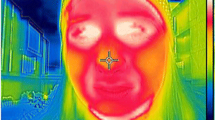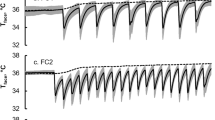Abstract
The effects of low to moderate wind speeds on face temperature, thermal and pain sensations while subjects walked on a treadmill during cold exposure were studied in eight healthy men. The purpose of the study was to evaluate further the risk of frostbite at different activity levels. The walking speed was 2.8 km h–1 and two inclination levels were used, 0° and 6°. The subjects were exposed to –10 °C and 0, 1 or 5 m s–1 wind for 60 min dressed in cold-protective clothing with only the face unprotected. Results from previous experiments with the same subjects standing for 30 min were included in the analysis of the data. Each individual was exposed to all combinations of air velocity and activity level. The exposure to –10 °C and the highest wind speed used would carry no risk of frostbite according to the wind chill index. Cold lowered the skin temperature of the face significantly and wind further increased skin cooling. The activity level did not affect forehead and cheek temperatures, but the average nose skin temperature was higher and pain sensations were reduced at a higher work rate. The predicted risk of frostbite in the nose, based on average responses, would thus be less at a higher work rate. However, the results indicate that exercise does not necessarily protect all individuals from frostbite at moderate air speeds, since the nose skin temperature of 25% of the subjects dropped to 0 °C at 5 m s–1 during both standing and walking. Thus the potential individual risk of frostbite in the nose is similar during light exercise and standing. Moreover, the risk of frostbite seems to be underestimated by the wind chill index under the conditions tested in this study.






Similar content being viewed by others
References
Bergersen TK (1993) A search for arteriovenous anastomoses in human skin using ultrasound Doppler. Acta Physiol Scand 147:195–210
Beynon AD (1973) Effects of an Antarctic environment on dental structures and health. In: Edholm OG, Gunderson EKE (eds) Polar human biology. Heinemann Medical Books Ltd, London, pp 105–113
Christensen EH, Nielsen M, Hannisdahl B (1942) Investigations of the circulation in the skin at the beginning of muscular work. Acta Physiol Scand 4:162–170
Danielsson U (1993) Convection coefficients in clothing air layers. Doctoral thesis, Royal Institute of Technology, Stockholm, Sweden, pp 1–250
Danielsson U (1996) Windchill and the risk of tissue freezing. J Appl Physiol 81:2666–2673
Du Bois D, Du Bois EF (1915) Clinical calorimetry. Fifth paper. The measurement of the surface area of man. Arch Intern Med 15:868–881
Dulac S, Quirion A, LeBlanc J, Cote J (1982) Effets du vent froid sur la réponse à l'exercise musculaire [Effects of cold wind on the response to muscular exercise]. Can J Appl Sport Sci 7:263–266
EN 28996 (1993) Ergonomics. Determination of metabolic heat production. Comité Européen de Normalisation, Belgium
EN ISO-10551 (2001) Ergonomics of the thermal environment. Assessment of the influence of the thermal environment using subjective judgement scales. Comité Européen de Normalisation, Belgium
ENV-342 (1998) Protective clothing. Ensembles for protection against cold. Comité Européen de Normalisation, Brussels, Belgium
Fox RH, Wyatt HT (1962) Cold-induced vasodilation in various areas of the body surface of man. J Physiol (Lond) 162:289–297
Fox WF (1967) Human performance in the cold. Hum Factors 9:203–220
Froese G, Burton AC (1957) Heat loss from the human head. J Appl Physiol 10:2:235–241
Gavhed D, Mäkinen T, Holmér I, Rintamäki H (2000) Face temperature and cardiorespiratory responses to wind in thermoneutral and cool subjects exposed to –10 °C. Eur J Appl Physiol 83:449–456
Goldman RF, Brebbia DR, Buskirk ER (1960) Heat loss during the night under subarctic conditions. In: Headquarters Quartermaster Research & Engineering Command, US Army, Natick, Technical Report EP-134
Hardy JD, DuBois EF (1937) The technique of measuring radiation and convection. J Nutr 15:5:461–475
Hassi J, Mäkinen T (2000) Frostbite: occurrence, risk factors and consequences. Int J Circumpolar Health 59:92–98
Josenhans W, Melville G, Ulmer W (1969) The effect of facial cold stimulation on airway conductance in healthy man. Can J Physiol Pharmacol 47:453–457
LeBlanc J, Dulac S, Cote J (1975) Autonomic nervous system and adaptation to cold in man. J Appl Physiol 39:181–186
Lehmuskallio E, Lindholm H, Koskenvuo K, Sarna S, Friberg O, Viljanen A (1995) Frostbite of the face and ears: epidemiological study of risk factors in Finnish conscripts. Br Med J 311:1661–1663
Linde EJG van de (1988) Heat loss from the head in the cold: new data confirm model. In: Ilmarinen R, Påsche A (eds) 3rd International Conference on Environmental Ergonomics, Helsinki. Institute of Occupational Health, Helsinki p 30
Midttun M, Sejrsen P (1998) Cutaneous blood flow rate in areas with and without arteriovenous anastomoses during exercise. Scand J Med Sci Sports 8:84–90
Mäkinen T, Gavhed D, Holmér I, Rintamäki H (2000) Thermal responses to cold wind of thermoneutral and cooled subjects. Eur J Appl Physiol 81:397–402
Mäkinen T, Gavhed D, Holmér I, Rintamäki H (2001) The effects of wind on thermal responses at different air velocities in −10°C. Comp Biochem Physiol [A] 128:759–768
Märk W (1941) Ueber arterio-venöse Anastomosen, Gefässperren und Gefässe mit epitheloiden Zellen beim Menschen. Z Mikrosk Anat Forsch 50:392–445
Ohlsson G, Hiltunen E, Anttonen H, Holmér I (1998) Wind effects on head heat loss. In: Holmér I, Kuklane K (eds) Problems with cold work. Grand Hôtel Saltsjöbaden, Stockholm, Sweden, pp 266–268
Osczevski R (1995) The basis of wind chill. Arctic 48:372–382
Osczevski R (2000) Windward cooling: an overlooked factor in the calculation of wind chill. Bull Am Meteorol Soc 81:1893–1899
Rasch W, Cabanac M (1993) Vasomotor response of the human face: laser-Doppler measurements during mild hypo- and hyperthermia. Acta Physiol Scand 147:431–436
Richardson D, Schmitz M, Borchers N (1986) Relative effects of static muscle contraction on digital artery and nailfold capillary blood flow velocities. Microvasc Res 31:157–169
Rowell LB (1986) Human circulation. Regulation during physical stress. Oxford University Press, New York
Siple PA, Passel CF (1945) Measurements of dry atmospheric cooling in subfreezing temperatures. Proc Am Philos Soc 89:177–199
Steadman RG (1971) Indices of windchill of clothed persons. J Appl Meteorol 10:674–683
Steegmann AT Jr (1979) Human facial temperatures in natural and laboratory cold. Aviat Space Environ Med 50:227–232
Wilson O, Goldman R (1970) Role of air temperature and wind in the time necessary for a finger to freeze. J Appl Physiol 29:658–664
Yermakova I, Maslovskaya N (1998) Heat transfer in the human head: results of modeling. In: Hodgdon JA, Heaney JH, Buono MJ (eds) ICEE 8. The 8th International conference on environmental ergonomics, San Diego, California, USA, pp 403–406
Acknowledgements
The authors wish to thank both the Swedish and the Finnish Work Environmental Fund for their financial support of the study.
Author information
Authors and Affiliations
Corresponding author
Rights and permissions
About this article
Cite this article
Gavhed, D., Mäkinen, T., Holmér, I. et al. Face cooling by cold wind in walking subjects. Int J Biometeorol 47, 148–155 (2003). https://doi.org/10.1007/s00484-003-0159-1
Received:
Accepted:
Published:
Issue Date:
DOI: https://doi.org/10.1007/s00484-003-0159-1




